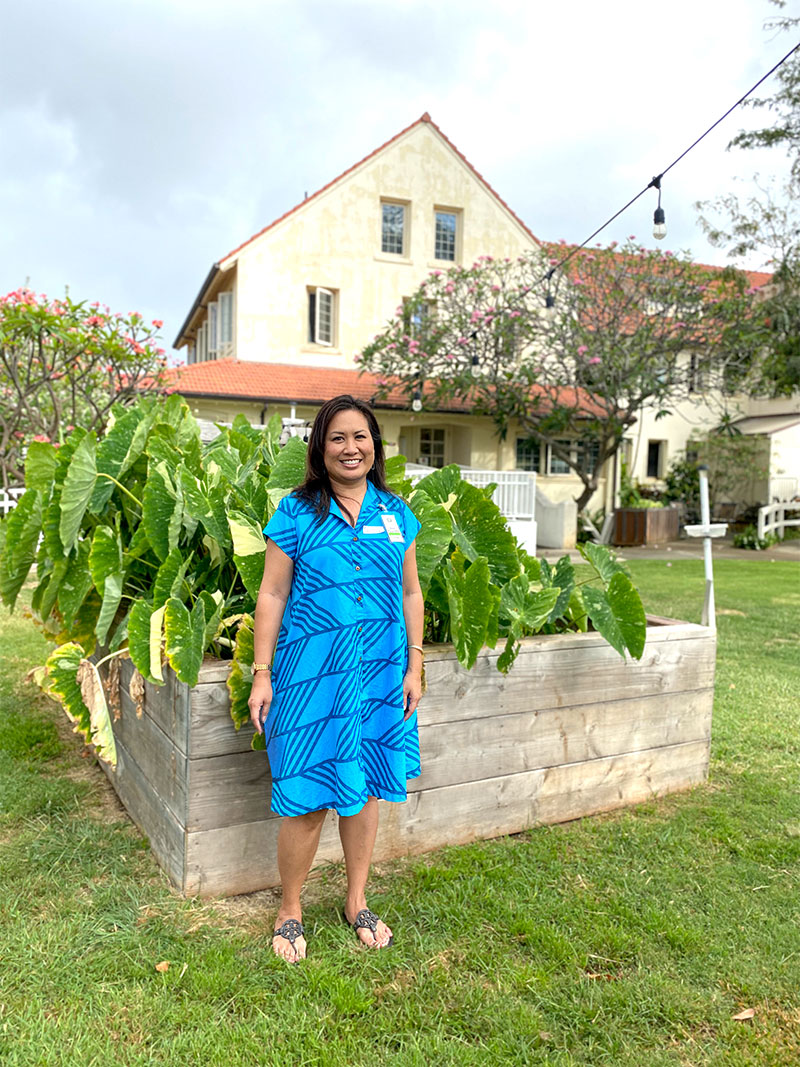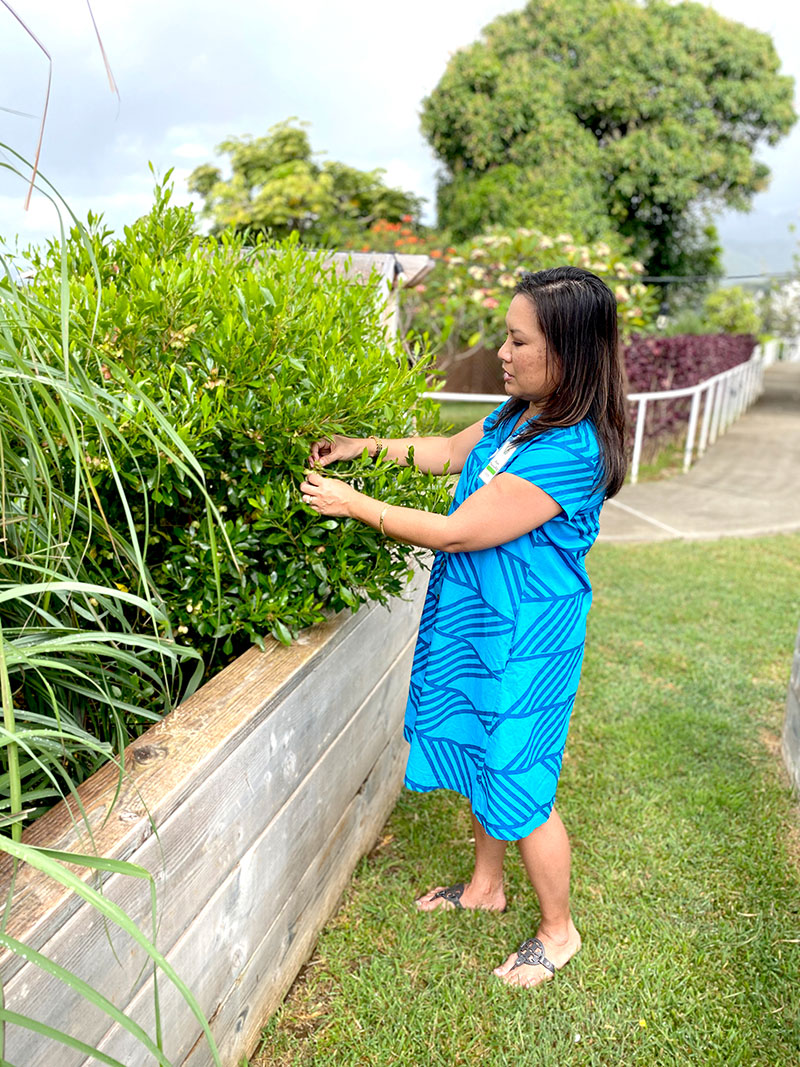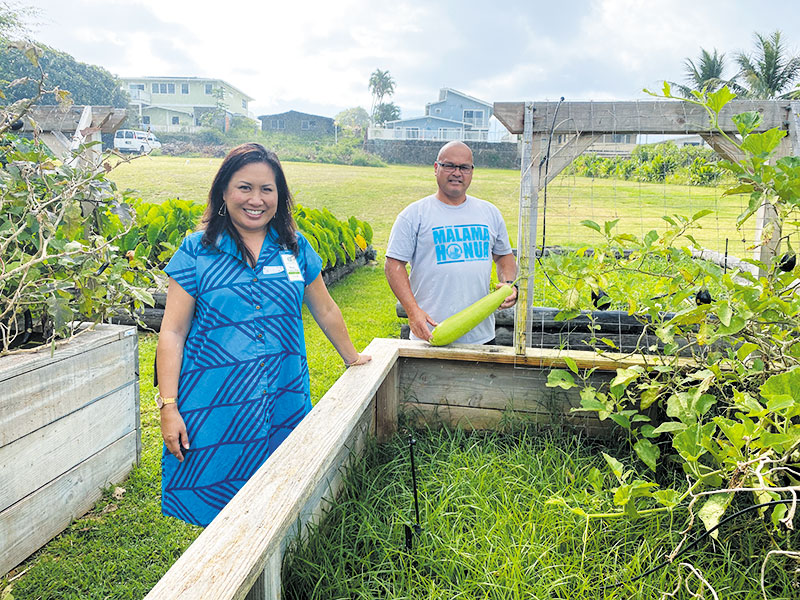The Right Person for Lunalilo

Ensuring that the legacy of Lunalilo Home “never ends” remains a priority for CEO Diane Paloma.
No one is better equipped to carry Lunalilo Home through its long-awaited transformation than CEO Diane Paloma.
Take a walk on the grounds of Lunalilo Home and you might think you’re caught in a time warp. After all, the century-old building still sits in the shadow of towering Koko Head, while the original porte cochere remains to welcome those entering the charming 5-acre property. Even the very first terra cotta roof tiles have endured and continue to provide safe haven for the home’s 32 kūpuna residents.
Yet in spite of all this sameness, change is in the air for the elderly care facility that has called Hawai‘i Kai home since 1927. And no one better embodies this age of transformation than its first-ever CEO Diane Paloma.
When she joined The King William Charles Lunalilo Trust in the fall of 2017, Paloma was charged with implementing an extensive strategic plan to revitalize the home and advance the well-being of its residents. Little did she know that waiting just down the road was an unseen enemy that would push her to her limits — but in time and with patience could potentially propel the organization toward its long-intended goals.

For Paloma, even healing plants such as ‘a‘ali‘i deserve a spot in Lunalilo Home’s raised gardens.
“Coronavirus has been a game-changer for us, just like it’s been for everybody else,” acknowledges Palo-ma. “There’s nothing like a pandemic to really put your mind into focusing on what your mission is. So it’s sort of been the kick in the pants we all needed.”
But did it have to kick so hard? While the care home still employs 39 staffers, it also had to give up dozens of community volunteers, many of whom provided valuable services such as leading the Friday afternoon kanikapila sessions. In addition, two annual fundraisers that help subsidize the facility’s overall operational costs — May’s Mahealani Moonlight Benefit Dinner and July’s golf tournament — are now history, and September’s second Mahealani benefit could get the ax as well.
Still, the hardest hits came in early March, when the facility began social distancing measures by suspending all family visits. Even simple activities like bingo had to be modified in order to prevent residents from touching the game chips and other fomites, and becoming infected.
“The little things that you take for granted are all potential risks around here and, knock on wood, we haven’t had any illness so far,” says Paloma. “We’ve found ways to socially distance our residents, so where they may have had all of their recliners lined up, for example, we’ve had to move the chairs around. Of course, if you’re a kūpuna and a creature of habit, that can be a huge change for you — one where you’re left asking, ‘Where did my chair go?'”

Developing raised gardens may have been Paloma’s idea, but it’s the responsibility of facilities manager Danny Smith to see that these areas flourish.
Despite the many challenges, Paloma insists she and her staff will be ready when life returns to what she calls “the new normal.”
“This coronavirus actually allows us to go through a total upheaval before settling into the most meaningful and sustainable stage for us,” says Paloma, who insists that her varied background as a medical assistant, health educator and administrator, and director of Native Hawaiian health prepared her well for the job. “In Hawaiian, we call it the huliau, which is when you upheave and turn, or you actually transform. So I’m hoping that when we come out of this, we will have transformed into what we always thought we could be.”
Facing Future
Paloma is a visionary who’s practical in her approach. She understands that many of the intended changes — such as, say, expansion — won’t happen anytime soon. Still, that doesn’t mean she can’t take small steps now to advance the trust’s cause, which is to accommodate the poor, destitute and infirmed people of Hawaiian blood, with preference given to the elderly.
“I realize I’m not going to be here to see the fruits of my labor, but I can set it up incrementally so that in 30 years, maybe we’ll have a Lunalilo Home on every island, or a Lunalilo Home in every community,” she states. “I mean I’m pretty sure King Lunalilo never thought, ‘OK, I’m just going to have one home with so many beds and kūpuna and that’s enough for my people!'”
She also talks about “changing the trajectory of the organization” and developing a greater sense of purpose among staffers — all to ensure that “this legacy never ends.”
“To me, what’s important is that we collectively uplift the kūpuna while uplifting the community and the families, so they can feel confident that when they send their elders to us, they’re going to a place where everybody takes pride in their work,” she says.
Back Where You Belong
Less than 10 minutes away from Lunalilo Home is a spot of land in ‘Āina Haina where Paloma first put down roots.
Today, the Kamehameha Schools’ alumna resides with her husband and three daughters in the same home she was raised in, although her appreciation for her surroundings has grown much in recent years.
“When I was young, I knew three people in my valley because they were the ones who went to Kamehameha with me — and Kamehameha was my community. Now, my kids can walk down the street and they’ll know somebody who lives on every single street in the valley,” explains Palo-ma, whose daughters attend schools in the East Honolulu district. “Having friends and a deep network in your own community is valuable and really helped shape my three daughters, and I love being able to see that through their lens.”
Following high school, Paloma chose to matriculate at UCLA. This was during the early ’90s, when things were quite chaotic in California. But Paloma’s own lens was always fixed on ultimately returning to her island home.
“I loved LA, but that was a time when there were the Rodney King riots, the O.J. Simpson trial and the Northridge earthquake, and after four years, I was done,” she recalls.
Moving On Up
Back in the islands, Paloma soon found a job at HMSA teaching fitness, nutrition and stress management to retirees. But although just 23 at the time, she was keen enough to notice there was “something wrong with the picture.”
“These guys who were retired were coming to my class and I was thinking they should be the ones teaching me how to be happy, how to be healthy and do all this preventive medicine,” Palo-ma says.
Eventually, she landed a position within a new department dedicated to Native Hawaiian health at University of Hawaii, John A. Burns School of Medicine. There, she would spend the next three years helping to develop the department’s strategic plan.
Then came the call from a friend about a similar position opening up at The Queen’s Medical Center. The only caveat: The application deadline was a mere three hours away.
Paloma wound up submitting her application on time and later nailing the interview — thus proving she could be clutch under pressure.
“I guess it was my first training ground for coronavirus,” she says, chuckling.
In describing her 11 years at Queen’s, Paloma explains, “I got to do a lot of cultural integration work with all the hospitals, including Moloka‘i General Hospital. It was such a great learning experience, and I couldn’t have asked for better training before coming here to Lunalilo Home because it’s very similar operationally to running a hospital. All of the things I had seen or experienced as a hospital administrator I do now, except I do it on a much smaller scale.”
Hula Is Life
One of Paloma’s earliest loves developed during her middle school years at Kamehameha. In hula, she not only discovered what she calls “my passion and my pastime,” but her foundational grounding for life as well.
“Hula helps me in my everyday life,” explains Paloma, who proudly numbers her 10 performances at Merrie Monarch among her most joyous occasions. “In my hālau, I am an alaka‘i, or a leader. Being a leader in a hālau has a lot of similarities to being a CEO because, in part, you have to learn how to motivate people.”
Additionally, she believes the art form is an ideal conduit for intergenerational knowledge to be passed down — and that’s a good thing when you’re hoping to preserve a rich legacy.
“I’m always thinking how I can incorporate these things here at Lunalilo,” says Paloma. “There’s all this intergenerational knowledge stored in our kūpuna, so for me, the question is, ‘How do I take that cultural knowledge, that Hawai‘i that they grew up in, and pass it down so that we don’t forget?'”
Home Grown
Even before the corona-virus hit, Paloma was taking steps to improve the residents’ quality of life. In the fall of 2018, for example, she challenged her team to begin developing raised gardens in the back of the property. Later, an aquaponics garden was added in the area just beyond the dining room lānai. The result: various types of kalo, squash, eggplant, lemon grass and more were planted and have since flourished.
More than just a move toward healthy fare and greater self-sufficiency, the gardens have breathed life into the elderly and helped them to access their fondest childhood memories of comfort food.
“I was thinking, ‘Hey, we have the land, so why don’t we try and grow something?'” Paloma explains. “I really wanted to incorporate kalo and ‘uala, and bring back these native Hawaiian foods to their diets. Our kūpuna grew up with poi bowls on the table … for many of them, this is their last residence before they move on, so why not bring back these childhood tastes?”
She pauses briefly before finalizing her thoughts. “You see, here at Lunalilo, we’re not just trying to feed their physical bodies, we’re trying to feed their souls.”






